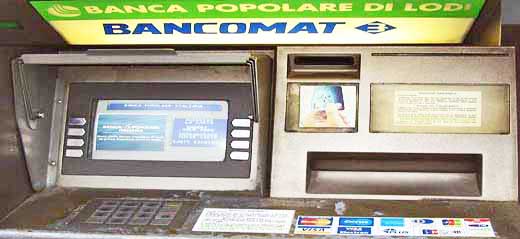ATMs in Europe
Machines Dispense Travel Cash
European money, changing money, ATM machines, PIN, banks.
Here is an ATM, Italian vintage in Milan. They call it a bancomat,
as in laundromat, a self-service laundry.
The instructions on screen are in four languages. Follow instructions.
Look for one of those card icons on the back of your ATM card. This stainless steel beast accepts a dozen
sorts of bank ATM plastic, but no credit cards.
I have yet to find an ATM machine attached to a bank in Europe which charges a fee. However,
your hometown USA bank will charge you, maybe $5.00 or 3%. Many credit unions do not charge a fee
for withdrawals in Europe. Look for the double delta icon with CO-OP Network on the back of your credit union ATM
card. However it seems that Mastercard is always in there to pick a few pennies on every transaction.
Carpe diem. Vivere bene! Gratia Deo.
Chapter 8 part 2 of
HOW TO EUROPE:
The Complete Travelers Handbook
John Bermont
This entire book is published totally free on-line by the author, photographer, and webmaster, yours truly, with help from my daughter Stephanie. I welcome all questions, comments, compliments, and complaints. For contact information please see NOTE TO READERS. Updated 18 November 2015.
Europe is a cash society.
This Internet edition of chapter 8 discusses money and such. It is divided into four parts because it is so big. It would be a very good idea to read part 1 or all else may be to naught. The four parts are:
- Pickpockets in Europe: They're Everywhere.
- ATMs in Europe: Machines Dispense Travel Cash.
- Cash and Credit: Paying Your Way in Europe.
- Money Potpourri: Cash, Coins, Transfer, Barter.
The first part of this chapter focused on the issue of protecting your stash. Now we get into the arena of money logistics, for lack of a better term.
How do you obtain and carry the money you need to pay for your everyday travel expenses? American dollars must be converted into European curencies, so where do you get the best deals when exchanging those beautiful dollars for Euro wampum? And how do you avoid getting screwed by high commissions, lousy exchange rates, expired bank notes, or even forgeries?
MONEY
Euro
Each European country formerly had its own currency. France had its franc, Germany had its Mark, Italy had its lira, Denmark had its krone, etc., etc. This changed significantly as of 2002. Most of the old currencies survived but the euro is now the official currency of 19 countries in Europe. It is also the de facto currency in other countries which are not officially a "member" of the Euro Zone. Also, it is accepted by many businesses outside the Euro Zone.
British Pounds, Swiss Franks, Danish Kroner, etc.
The major national currencies which survived the euro takeover were the British pound and the Swiss Frank. When you use an ATM in those countries you will receive pounds and Franks, and those are the only countries where you can use the respective currency.
Greenbacks
United States dollars are legal tender in the United States for goods and services and taxes. You normally cannot use dollars in Europe. In most countries of Europe, the only thing you can legally buy with United States dollars is the currency of the country in which you are present. These currencies are sold by banks and other businesses in accordance with national laws. Each bank or place of exchange posts buying and selling rates for major currencies, although the eight digit decimal rates in the computers are actually used in calculating the transaction.
Money changing is a free market, like the fish market. If there is an "official rate" you will never see it. Exchange rates are very competitive because every money changer knows what all the rest are doing. However there are some differences when it comes to the sneaky subject of "commissions." More about that below.
My page The Euro and Other Currencies: Exchange Rates for Travel in Europe gives you a quick introduction to the kinds of cash used in Europe.
WHERE TO CHANGE MONEY
One of the first things you need to do in Europe, or before you go, is obtain some local currency. There are several ways to do this.
Your Home Town
Ask your bank about buying some euros, kroner, pounds, or whatever you will need on arrival. Do not be surprised if you get a blank stare. If they can help you, they will probably need to order the money for you. It will take a week for delivery. The bank will charge a ridiculous astronomical fee for the service.
Normally you can buy some foreign currencies at the exchange office in your USA departure airport. This will also be expensive. I check the exchange rates offered when I fly out of Los Angeles, Minneapolis, or Detroit. Invariably the rate is approximately 20% worse than the rate given in the Wall Street Journal. That spells ripoff to me.
If you are a fool with money and don't want to stand in line at an airport, try to change at a large hotel near your departure airport. World class hotels usually change major currencies for their guests. This can cost you 20% to 30% more than at the airport. It is more than a ripoff, approaching grand larceny.
In Europe
The traditional place to change money is at just about any bank in Europe. The exchange rates are reasonable and are usually posted in a window or at the door. Banks in the city offer a better exchange rate than those at the airport.
There are also numerous money exchange offices in major cities. These places can be tricky as pointed out later in this chapter. They are sometimes associated with another business that travelers typically need or want, e.g. cameras, jewelry, etc.
Never change money with anyone on the street. You will be approached fairly often in some cities.
The best cash option is to use your ATM card when you arrive in Europe. This is one of the handiest and probably the best deals you will find. Cash machines are ubiquitous in Europe. With virtually any American ATM card you can obtain local currency at ATM cash machines in European airports, tourist offices, train stations, and on bank walls. In fact, I saw one bank which labels its cash machines "Hole in the Wall." Gee, I wonder how they dreamed up that name, Butch and Sundance. Debit cards may work in ATMs. Using a credit card for a cash advance usually is not allowed. Go to a bank if you want to do this.
Banks
It used to be that virtually all banks in Europe exchanged foreign money, and they usually offered the best exchange rates. They all knew what each other was doing so it was hard to find any real bargains.
Most banks in the Euro Zone of Europe are no longer in the currency exchange business. The reasons for this change of heart are that the euro is the common currency of half of Europe and ATM machines are now more common than dog poop on the sidewalks. There is very little business in the 9-to-5 mano-a-mano currency exchange enterprises nowadays. ATM machines can do it 24/7. However, there are still a few countries which are not in the Euro Zone, notably Britain, Switzerland, Sweden, and Denmark. You will find banks and forex offices in these countries which will exchange currencies if you want, but the best source of local cash is always an ATM machine attached to a bank. See the section on ATM machines below. See The Euro and Other Currencies: Exchange Rates for Travel in Europe for details on the Euro Zone.
Since banks pay rent, salaries, and interest on their inventory, and expect to make a profit, a spread exists between buying and selling rates. They buy low and sell high. Thus, when arriving in Copenhagen and buying kroner you might receive five kroner per dollar, but the next person in line returning home will have to pay six kroner for each dollar when he cashes in his excess. It's like buying a new car — instant depreciation. So, don't buy more money than you think you will be using in any one country.
In addition to the buy/sell spread, there is usually a transaction fee, normally called a "commission." This is sometimes a flat amount (so it is better to make large transactions to reduce the relative amount) or it can be a percentage of the transaction.
Some money exchange stores have huge NO COMMISSION! signs above the window. OK, now read the small print next to that asterisk. No commission usually applies to transactions of $1,000 or more. Anything less than that will cost you, probably 10%. Ouch!
Procedures
When exchanging money in some banks, you give your cash to a clerk at one window who calculates the transaction. He gives you a plastic or metal token with a number on it, and passes the paperwork to another window, the cashier. Shortly, the cashier will call out your number, in the native language of course, and pay you the money. If you can't understand the local language, you won't know when it's your turn. It's a good idea to keep your eyes on your paperwork behind the counter so you know when it's your cash being dished out. In a bank in Holland they once tried to give me somebody else's money.
When
If you need to go to a bank it's best to do in the morning. Lines are longer at noon (if the banks are open during lunch) and in the afternoons. Siestas can last until 16h00. That is 4:00 PM.
Airports
International air terminals in Europe almost universally have an exchange window and/or a bank. There is also at least one ATM machine. On arrival it would be a good idea to get about $100 in foreign currency right there at the airport. This should more than cover your expenses in getting to town and checking in at your hotel.
The exchange rate is not as good at airports in the USA as it is in Europe because the
European currencies have little demand in our country. For example, in passing through the
Detroit airport in June 2011 I noted the euro exchange rates posted
by the money changer.
Buy: $1.24201
Sell: $1.61318
The real exchange rate that day was $1.43207 per euro. If you bought your euros that day
at $1.61318 you were paying 12.6% too much. If you were coming back from Europe with extra euros
and sold them here you would be shortchanged by 12.6% also. You are screwed coming and going.
Arriving at Schiphol Airport in Holland a few years ago I went to the ABN-AMRO bank window in the entry hall and swapped $100 for euros. Later that day I exchanged more at the ABN-AMRO branch in Haarlem. Not only did I get a slightly better exchange rate in Haarlem but the commission was also less. The difference was about a 1% benefit in using the Haarlem branch for exchanging money.
Train Stations
Most major train stations have an exchange office with extended hours. Usually it costs you more to buy foreign currency at these offices. You pay for the convenience. I have seen buy/sell spreads at some train station exchange offices of 8% to 9%. The spread should be about 2% with a strong dollar. Look for an ATM cash machine in train stations.
Ships
Ships and ferries crossing international borders have exchange windows which operate more or less like banks. Usually exchange windows on ships are only open during part of the journey. Open hours will normally be posted at the exchange window and/or announced over the public address system. If you cannot find an exchange office ask the purser if he will make an exchange for you. Ports do not have convenient exchange windows.
American Express
Many Americans formerly used American Express offices to exchange money or to cash travelers checks. The Paris office near the Opera was a very busy place back in "the good old days." You could easily spend an hour waiting in line. Holders of Amex cards received expedited treatment.
The street curb out front was also a busy market for used VW camper vans, as was the curb outside the Amex office in Amsterdam. That also was in "the good old days."
Money Changers
Exchange rates for small amounts are not as good as for larger amounts. The best exchange rates are the ones in foot high lettering. The little asterisk next to that refers to the bottom of the sign where the rate is 10% less for amounts less than $1,000.
In Paris a number of years back I had some left over Deutschemarks and needed to change them for French francs. I was seduced by what appeared to be an excellent rate for Deutschemarks with no commission charge. Instead I was shorted by about 10% because the small print said that the exchange rate was only for amounts over $1,000. I didn't read the small print. Heck, I didn't even see that tiny print at the bottom of his poster after reading the good exchange rate in big letters at the top. I asked for my money back and the teller refused. Whereupon I took his picture, told him he was a thief and that I would put his picture in my next edition. Whereupon he bounced out of his booth and tried to take the camera out of my hand. The scuffle didn't last long and I kept my camera. His face isn't worth the ink.
Last Resort
When I was living in Geneva, Switzerland I would often make day trips over to France on weekends. Usually I had enough French francs with me but one Sunday I was short. I was stymied everywhere in town trying to change Swiss Franks for French francs. It was Sunday and the banks were closed. Hotels would change money but only for their guests. Finally, I went into the casino at Aix-les-Bains and bought casino tokens with my CHF. At another cash window I traded all the tokens for FF and received as good an exchange rate as at a bank, had one been open.
ATM MACHINES
Your Bank Card
One of the really amazing developments in our society over the past 20 years has been the introduction of automatic teller machines. We call them ATMs in the USA. Overseas they are known as money automats, cash machines, bancomats, or something similar, in the local language. You can use most American ATM cards in these macchines throughout Europe. These cards are usually identified on the reverse with names like Cirrus, Star, Plus, and others. These names are also used in Europe and where you see them you can usually use your matching ATM card. Your bank will probably charge a fee of up to $5 for each transaction. I closed my rip-off bank account and opened an account at a credit union which has no fee for foreign cash withdrawals, and uses the best exchange rate. I have never been charged by a bank in Europe for using my American ATM card. It is common practice in the USA to be dinged twice if you use your ATM card anyplace other than at the bank which issued it to you.
The money you receive in Europe is local currency and is deducted from your home bank account after the banks make the conversion calculation and tack on their fees, if any. Typically there are several buttons allowing you to select 50, 100, 200, or 300 of the local wampum.
Bank systems have regularly scheduled maintenance periods when you may not be able to access cash. Ask your home bank about this before going to Europe. The off period is probably the wee hours of the day at home, which can be mid day in Europe.
In Germany we lived near a US Army base which had an ATM machine dishing out US dollars, US dollars being the coin of the base. The machine was outside the fence so anybody could draw dollars without paying exchange commissions to a German bank. I used the machine several times with my German bank card before they put up a notice warning that it was to be used only by military personnel. Dollars came in handy for my trips to the eastern countries. The former communist countries love American dollars.
Credit Cards
Theoretically you can also use your credit card with personal identification number (PIN) to take cash advances according to the terms and limits of your credit card account. However European banks don't seem to want to do this anymore. I have seen notices at some ATMs advising that credit cards cannot be used for cash withdrawals. I accidently put one of my credit cards in an ATM in Edinburgh, Scotland. It didn't come back. I called the bank which owned the ATM machine and was told that the card would be destroyed. So I had to cancel that account and get another credit card. This kind of thing can be a major headache if you have recurring debits, say a phone bill, being charged to your card. It would be best to leave that card at home and use another card as a "traveling credit card." Go on to part 3 Cash and Credit: Paying Your Way in Europe for information on using credit cards in Europe and more stuff you need to know.
PIN
Make sure that you remember your PIN as a number and not as a word. The reason is that most European ATMs do not have alpha characters and the number pads do not have the same pattern as ours at home. For example, if your password/PIN is "cash" remember it as 2274 or you may have trouble accessing your account.
Four digit PINs are the norm in Europe's ATMs. If you use a 5 or 6 digit PIN change it before your trip or you may not be able to use your card in some cash machines. Some people say that 4 digit PINs are a myth. I don't think so. My American bank and credit union allow only 4 digits in a PIN. I don't like that because it is relatively easy to crack a four digit code. There are only 10 numbers to deal with and an electronic device could shuffle through all possible combinations in a second. For my on-line accounts I use mixed alpha-numeric 16 digit passwords. That can use up to 62 characters instead of 10 and four times as many possible combinations. I don't know the odds of cracking this kind of a password but they are akin to winning a lottery jackpot in a few lifetimes.
Fraud
Where there is cash there are criminals. Try to use more secure ATMs such as those attached to banks, not free standing units in stores and train stations. ATMs are not regulated as banks are and anybody can buy an ATM and install it anywhere. Some of these have been modified by the ATM owner (not necessarily the store owner) to harvest account and PIN numbers. Thereafter the crooks cleaned out the bank accounts of many people. It is reported that this sort of crime is much more common in Europe than in the USA. And heck, with 50 different national police agencies in Europe crimes like this easily fall into the cracks.
To protect yourself against theft at ATM machines you must act somewhat paranoid. Assume that all of your actions are being watched, photographed, and recorded. Physically, the crooks often use a device which fits into the card slot. It reads your name and number. Easily available plastic card machines can then make a working duplicate of your card. Of course the crooks also need your PIN number. To get this they watch and maybe video your fingers as you enter your four digits. To guard against snooping you must cover your hand. So put your other hand over the hand which is entering the numbers. At the same time hunch over the key pad. If anybody gets too close turn and stare them down until they leave. Beware of pretty young women, or charmng dudes if you are a woman.
Have a good trip!
NOTE TO READERS
I welcome questions, comments, complaints, and compliments. If you have any concerns about your trip to Europe that have not been covered well enough on my web site please do not hesitate to write. Ask, cuss, discuss, or whatever. I read every email and update my pages when I see a question repeating, Then I will not get that question again, hopefully. In some cases readers have been so generous with their time and talent that I have included their emails verbatim, e.g. chapters 22 and 25.
I do not open attachments. I do not click links to web pages of any kind. I will reply in a day or two, usually.
My email address is [email protected].
Do not forget to smell the hyacinths. At your liesure scroll through the Table of Contents of HOW TO EUROPE: The Complete Travelers Handbook and read all 30 chapters, FREE on line. Good deal! You'll probably find the answers you seek, and some you didn't know you needed.
FREE
This web site is totally free for everyone, and a labor of love for me. To keep it afloat I receive a commission from Amazon.com for all goods purchased through the adverts I have selected, and any other products you might buy when you are on the Amazon site. Amazon has almost everything for sale, except the Brooklyn Bridge and Mount Rushmore.
Please visit my on-line store at
 .
Your support is most gratefuly appreciated. TIA.
.
Your support is most gratefuly appreciated. TIA.
To like and like not:


Adverts
To support this site:
Please buy your goods at:Amazon.com
Shop in your shorts!
Please clean out your cookie jar before clicking.
Rolling luggage sure beats lugging a pack on your back.
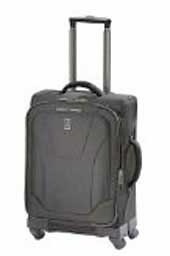 Travelpro Luggage Maxlite 2 20" Expandable Spinner
Travelpro Luggage Maxlite 2 20" Expandable Spinner
A shoulder bag for your daily walk-about.
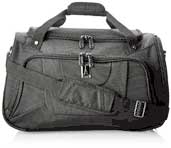 Travelpro Luggage Maxlite3 Soft Tote
Travelpro Luggage Maxlite3 Soft Tote
Keep your stuff organized.

Luggage Packing Cubes
eBags 3pc Set
The two gallon size is excellent for packing your clothes, but it is hard to find in Europe.
 Two gallon plastic bags
Two gallon plastic bagsZipLoc by SC Johnson
Inconspicuously lock your zippered luggage with a black wire tie.
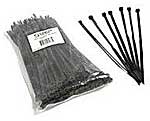 Cables to Go 43036 Cable Ties - 100 Pack (Black)
Cables to Go 43036 Cable Ties - 100 Pack (Black)
A Swiss Army Knife is unquestionably the handiest item a traveler can carry, except not on a plane.
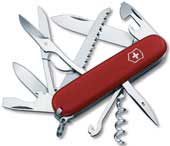 Victorinox Swiss Army Huntsman II Knife
Victorinox Swiss Army Huntsman II Knife
Note: The highlighted #E number is purely arbitrary. It is meant to help quickly identify products in this advert column when you write in for electrical advice.
See NOTE TO READERS.
Plug adapters are needed throughout Europe. There are at least five models used in different countries.
This adapter is for the standard grounded plug in France, Germany, and northern Europe. It does not fit in outlets of Italy, Switzerland, Ireland, and Britain.
#E-010
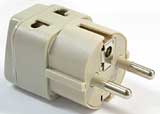 Grounded Universal 2 in 1 Plug Adapter
Grounded Universal 2 in 1 Plug Adapter
European Schuko plug.
4.8 mm prongs.
Equivalent to type E and F.
You can use this ungrounded Euro plug in some European countries.
#E-020
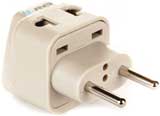 Universal 2 in 1 Plug Adapter
Universal 2 in 1 Plug Adapter
Euro Plug
4.0 mm prongs.
Equivalent to type C.
This is a universal plug adapter for the UK and Ireland.
#E-030
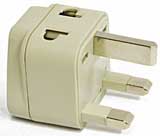 AC Adapter Plug for use in England, Scotland, Wales, and Ireland
AC Adapter Plug for use in England, Scotland, Wales, and Ireland
Equivalent to type G.
Here is the Swiss version.
#E-040
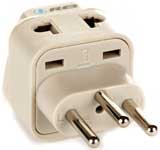 Grounded Universal 2 in 1 Plug Adapter
Grounded Universal 2 in 1 Plug Adapter
Type J for Switzerland
Here is the grounded Italian model.
#E-050
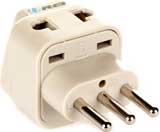 Grounded Universal 2 in 1 Plug Adapter
Grounded Universal 2 in 1 Plug Adapter
Type L for Italy
This 110-250 volt power surge strip has three universal outlets and an American grounded plug so it needs a plug adapter for the countries you are visiting. Make sure your gizmos are rated for 110-240 volts.
#E-060
 SM-60 Universal 3 Outlet Power Strip Surge Protector for Worldwide Travel. 110V-250V with Overload Protection.
SM-60 Universal 3 Outlet Power Strip Surge Protector for Worldwide Travel. 110V-250V with Overload Protection.
If your gizmos charge through a USB port this can keep you going. European cars have the same 12 volt system as American cars.
#E-200
 Scosche Dual USB
Scosche Dual USBCar Charger
The links in this pink field take you directly to a page at Amazon.com. The Amazon page details the item, and in most cases includes candid and critical comments from others who have bought the item.
Amazon pays my site a small commission when you click and order an item, if you put it in your shopping cart within 24 hours based on the cookie they set on your computer. If you don't want to make a quick decision just put it in your shopping cart, think it over, and come back later. The revenue covers the cost of maintaing this web site and keeps it free to users.
You benefit when buying here because Amazon has:
- 20% - 30% discount on many items,
- free shipping deals, direct to your door,
- no sales tax on internet purchases in most states,
- zillions of products, well almost,
- fast delivery even when it is free,
- shipment tracking in UPS, USPS, FedEx,
- easy returns if you are not happy with the product.
You win we win. Thanks for your support!!
Have a good trip in life,
John Bermont
Note: Italicized notations by the author.
This 50 watt 220/110 volt step down transformer is good for mall appliances.
#E-070
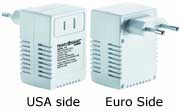 Travel Smart by Conair 50-Watt International Transformer
Travel Smart by Conair 50-Watt International Transformer
Wear a money belt under your shirt to protect your passport and valuables, especially if you are staying in hostels or dorms.
 Lewis N. Clark RFID Blocking Waist Stash
Lewis N. Clark RFID Blocking Waist Stash
An RFID blocking wallet protects your passport and credit cards from identity theft in public places.
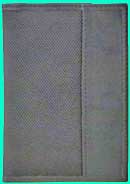 Travelon RFID Blocking Passport Case
Travelon RFID Blocking Passport Case
Inconspicuously lock your zippered luggage.
 Cables to Go 43036 Cable Ties - 100 Pack (Black)
Cables to Go 43036 Cable Ties - 100 Pack (Black)
This will come in very handy very often.
 Fenix LD15
Fenix LD15High Performance
LED Flashlight
